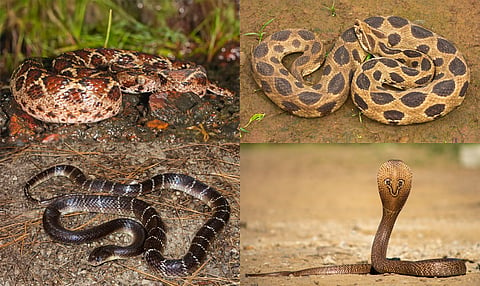

A study reveals that India's 'Big Four' snake species will migrate northward due to climate change, impacting snakebite management.
The Common Krait, Russell’s Viper, Saw-scaled Viper, and Spectacled Cobra, responsible for most snakebite fatalities, will find new habitats in northern and Northeastern India, increasing risks in these regions.
The ‘Big Four’ species of snakes, which cause the maximum number of snake bites in India, will migrate towards the northern and Northeastern parts of India due to climate change in the future, a new study has stated.
Certain states currently which currently exhibit the most suitable habitats of these species, will likely experience a pronounced reduction in regions classified as highly suitable for these species, the analysis added.
This could have serious repercussions towards efforts to tackle snake bite, classified as a Neglected Tropical Disease in India.
The Common Krait (Bungarus caeruleus), the Russell’s Viper (Daboia russelii), Saw-scaled Viper (Echis carinatus), and Spectacled Cobra (Naja naja), are responsible for over 90 per cent of all ‘envenomations’ or posionings in India.
“The vulnerability assessments by previous studies indicate exposure to these snakes, which lack effective antivenom treatments. The Big Four species are thus considered the most medically significant and dangerous snake species in the region, believed to cause the vast majority of snakebite fatalities,” the paper noted.
It added that while other venomous species are known to cause lethal envenoming, their bites are relatively rare and lead to a much smaller number of deaths each year compared to the Big Four species.
India is the most vulnerable country in Asia and responsible for nearly half of the global snakebite fatalities.
The researchers wanted to assess the present distribution of the Big Four species and their future dynamics under various climate change scenarios in India.
They also wanted to develop a risk index for each district and state for each of the Big Four species in present and future scenarios.
The experts used secondary data sources from the International Union for Conservation of Nature (IUCN) Geospatial Conservation Assessment Tool (GeoCAT) website (https://geocat.iucnredlist.org/) and GIS-based analyses.
“In future climatic scenarios, the Big Four snake species are projected to experience a decline and shift in their geographic ranges, primarily towards Northern and Northeastern India,” they wrote.
The researchers noted that in the case of the saw-scaled viper, Karnataka presently boasts the most extensive coverage of class 5 habitats (indicating maximum suitability).
The state is projected to experience the least severe reductions especially in the western region, with anticipated declines ranging between 12 per cent and 44 per cent.
In contrast, specific regions including Haryana, Rajasthan, Assam etc. are projected to witness an expansion in suitable habitat extent in response to shifting climate conditions.
“Furthermore, states such as Manipur, Meghalaya, Nagaland, and Arunachal Pradesh, which currently lack any suitable habitat, are predicted to experience notable increases in habitat suitability for the Big Four in future climate scenarios. These Northeastern states are projected to experience a significant increase (>100%) in habitat suitability for the Big Four due to the anticipated changes in climatic conditions,” the paper highlighted.
They concluded that as the shift towards the northern and northeastern states significantly overlaps with agricultural and urban areas, the risk of snakebites in these regions will increase in the near future.
“Addressing the challenges posed by these species as a result of climate change will require coordinated interventions from government authorities, regional and states and districts-level health organizations, and the international community to manage this NTD effectively in India,” the paper added.
The paper, titled Future of snakebite risk in India: Consequence of climate change and the shifting habitats of the big four species in next five decades, has been published in the journal PLOS Neglected Tropical Diseases. The authors include Imon Abedin, Hey-Eun Kang, Hemanta Saikia, Won-Kyo Jung, Hyun-Woo Kim and Shantanu Kundu.